░░ ░░ ░░ ░░ ░░ ░░ ░░ ░░ ░░ ░░ ░░ ░░ ░░ ░░ ░░ ░░ ░░ ░░ ░░ ░░ ░░ ░░ ░░ ░░ ░░ ░░
Never Enough
of violin pieces
Introduction to Writing for the Violin || lecture/workshop with dejana sekulić (first given at CeReNeM, University of Huddersfield, UK)
[1st update: 08.03.2021; 2nd updated: 07.03.2022; 3rd update: 25.02.2023; 4th update: 01.03.2024]
contact [at] dejanasekulic.com
Before continuing, please note that even done with care and dedication, this is still an extensively incomplete list of things that can be done with the violin. It is a rough overview of fields and areas of things to be considered when writing for the violin. Almost
⬨ Please note that further additions might (will most likely) appear, and more sound examples are going to be added; if a specific question arises, please feel free to send it!
☉ A bit from the basics
- ◌ range in standard tunning
- ▪ violin can (and is standard wester music use) is most commonly tunned in just or "perfect" fifths, with 3/2 ratio. In western music, the tunning is commonly in equal tempered fifths between G3-D4-A4-E5 (see image below for few more details)
- ▪ with standard tunning the range is G3—A7
- ▪ extension of the range above A7, while keeping standard tunning: with some violins to C8 (and in case of very specific timbre, even further; in this case other elements can interfere including rosin on the strings sticking on the fingertips; there is a "trick" of using nail instead fingertips)
- ▪ extension of the range below G3, while keeping standard tunning: subharmonics (mentioned in more detail under "harmonics")

- ◌ sound (“color”) of the strings
- ▪ important to take in consideration when thinking of the atmosphere and aura of music (phrase, melody, motive...)
- ▪ if nested in pitch: there are multiple possibilities for many of the pitches to be executed on a different string (but not all) in different positions (see positions), allowing for minute nuance
- ◌ positions

- ▪ 14 common positions
- ▪ please note that no two violins are the same, meaning that this diagram and marking is approximate, done over a picture of one specific instrument. An "absolute finer/position" chart that can be applied to any violin is not possible. With this said, it is still a good rough representation of the division of the fingerboard and location of the pitches
- ▪ in some cases also possible to add two more, with the use of the thumb (or other more apporpriate fingers) nail
- ▪ the thing to note: the distance between finger places for the notes becomes closer and closer, going up on the fingerboard. This means that the hand frame is going to change and become tighter. Maintaining unchanged spacing of fingers in the hand frame results in the different mapping of the instrument, allowing for different pitch-combinations, or alternatively completely not relying on the pitch. Aaron Cassidy in "the green is where" and "The Crutch of Memory" uses this, or rather precisely opposes this parameter, by focusing on not connecting hand-frame to pitch (the pieces are gesture-based, and the gesture itself is considered one of the main music matters).
- ◌ chords
- ▪ starting resource: chord catalogue Zukofsky and Cage made (when Cage was writing Freeman Etudes).
- ▪ please note - although extremely detailed and thorough, this catalogue is not an absolute and final rendering of possibilities
- ▪ please also note - some chords might be of a more strenuous nature to the hand, and this might make some chords highly uncomfortable (to unplayable) for certain (especially smaller) hand-types

☉ A bit less "basic", but very important (as everything else, thus still basic)
- ◌ scordatura
- ▪ the range is substantial; it depends on the desires and necessities of the composers' ideas
- ▪ important: the change of tension of the strings can have effects on the instrument; this is not mentioned as discouragement, but just as an aspect of the scordatura tunning that one has to be conscious about, and take in consideration also
- ▪ the vast amount of possibilities: allows for exploring and finding rich timbre, tensions or relaxations, and possibilities that standard tunning might lack off
- ▪ some examples (of course, there are many more): Eugene Ysaÿe: "Poème élégiaque in D minor, Op.12" (1896), Liza Lim's violin pieces ("Philtre" and "The Su Song Star Map"), Aaron Cassidy (see above), Pierluigi Billone...
- ◌ different intonation approaches [one example: just intonation]
- ▪ many tuning systems: equal, well-tempered, just, octave- and non-octave based, to name a few, each with their own virtues and restrictions)
- ▪ just intonation represents a tuning concept in which the tuning is done according to the ratios of the harmonic series
- ▪ often referred as “pure”, and one of the reasons for it is that in practice once achieved, the relationships between intervals of sustained notes do not produce any audible beating (“buzzing”) between the sustained pitches
- ▪ (in notation) the pitches are given as fractions that are rations between the named pitch and a constant fundamental
- ▪ any arbitrary decided pitch can be defined as fundamental upon which the rations will be calculated (by the composer of the music)
- ▪ Randy Gibson: “exploring the energy of pure ratio, expressed as tuning, heard in the real world. [..] It allows us over time to expand our focus from tuning a single ratio perfectly to experiencing a rich web of relationships.”
- ▪ some examples (of course, there are many more): Chiyoko Szlavnics: Quick Figure (for Marc Sabat) (2010) ...
☉ Left Hand
- ◌ finger pressure
- ▪ full stopped string (“normal”), harmonic pressure, many-in-betweens
- ⬨ example of held note with change of finger pressure from fully pressed string, over semi-pressed to harmonic pressure
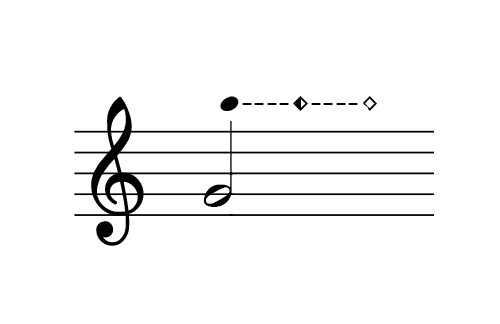
- ◌ vibrato
- ▪ oscillations/waving/wobbling in sound, produced by "wiggling" of the finger/hand/wrist/arm
- ▪ in more standard, widely applicable use 'till the mid-20th century (but also not prior late 19th) the action is used to embellish sound, and notes, without noticeable changing of the pitch
- ▪ “old” school: finger, wrist, hand. However, the range is much bigger. [an excellent example from recent repertoire: Rebecca Saunders' Hauch (2018)
- ◌ harmonics
- ▪ natural, artificial
good resource: Paul Zukofsky's harminics charts; Andrew Hugill's harmonics charts- ▪ other non-standard
- ▪ multiphonics (good resource, athough for cello (but still excellent!): Ellen Fallowfield's cello map)
- ▪ subharmonics (good resource: Mari Kimura)
- ▪ Some examples to listen/study can include: Liza Lim's violin pieces ("Philtre" and "The Su Song Star Map"), Salvatore Sciarrino: "Sei Capricci", Bryn Harrison: Receiving the Approaching Memory, Lucio Tasca: An Imperfect Circle
- ◌ left-hand pizzicato
- ▪ some of the possible ways to notate:
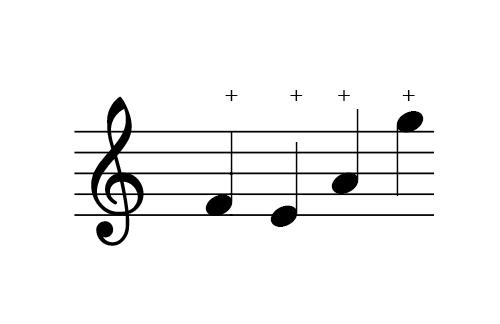

- ◌ more: trillers, glissandi, combinations...
☉ Right Hand
- ◌ point of contact
- ▪ “common” area for playing between the bridge and the fingerboard
- ▪ 1st degree expansion": poco sp. → ord. → st.
- ▪ furhter degrees of expansion
- ◌ bow strokes
- ▪ more common (détaché, legato, martelé, staccato, spiccato, ricochet..)
- ▪ more and more common; all possiblites can appear in many variations
in more common violin playing, the bow is bowed horizontally and (important!) parallel to the bridge; thus, the "name" to these bowing; bow strokes and articulation from the "common" list can also be explored in orientation alternative to the "parallel to the bridge". - ▪ Helmut Lachenmann uses also the screw of the bow (very characteristic) [recording example will be added]
- ◌ pressure
- ▪ "ordinary"
- ▪ From very light, over “ordinario”, to heavy pressure
- ⬨ sound examples, and examples of notation will be added
- ◌ bow speed
- ◌ flautando: a special combination of light bow pressure, specific care for speed and point of contact (very particular sound)
- ◌ pizzicato
- ▪ plucking of the string
- ▪ range of possibilities, even though there is a clear volume limit (which should be taken into consideration: when in combination with bowed playing (bowed with hair of the bow), the range of dynamics cannot be considered the same among the two (example: forte in hair-bowed and pizzicato production of sound will not be of the same volume)
- ▪ some of the possible ways to notate:



☉ Preparation
Preparation can be doen in many ways, with many elements; explorations are the key to finding that "right" timbre and tone. Preparation can be done to the violin or to the bow.
- Some examples of preparation
- Robert Wannamaker: violin

- Clara Iannotta: dead wasps in a jam-jar (I)
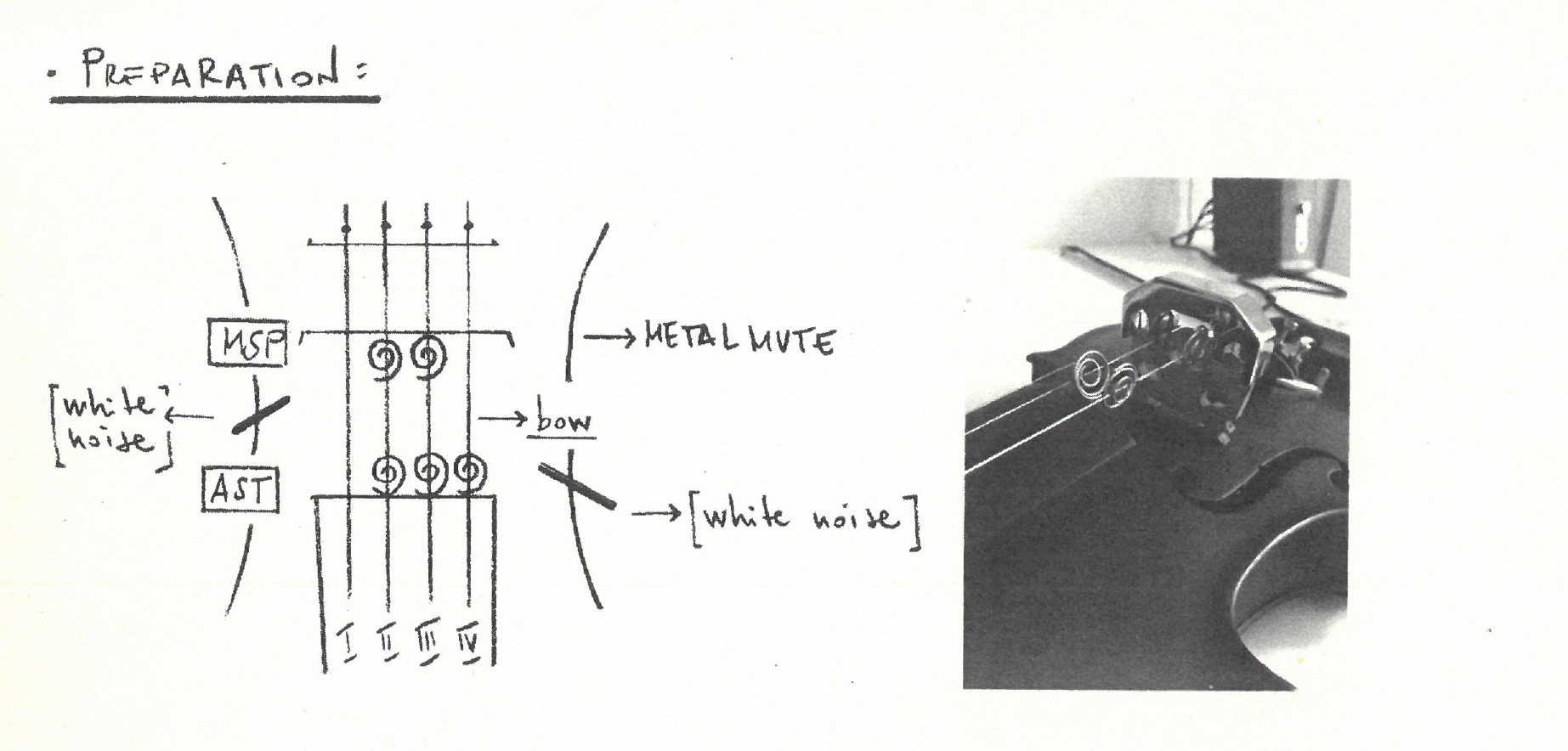
- Keeril Makan: Mu
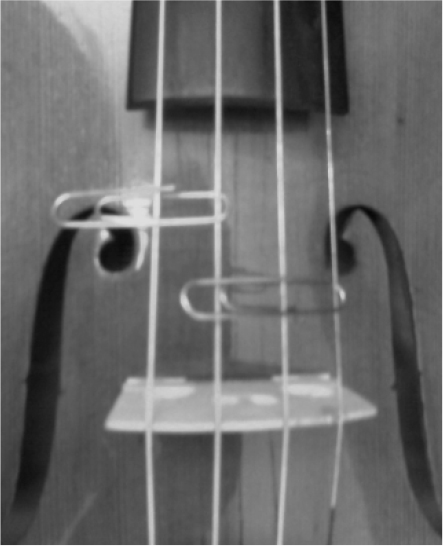
- Anahita Abbasi: Situation IV - Io E iO
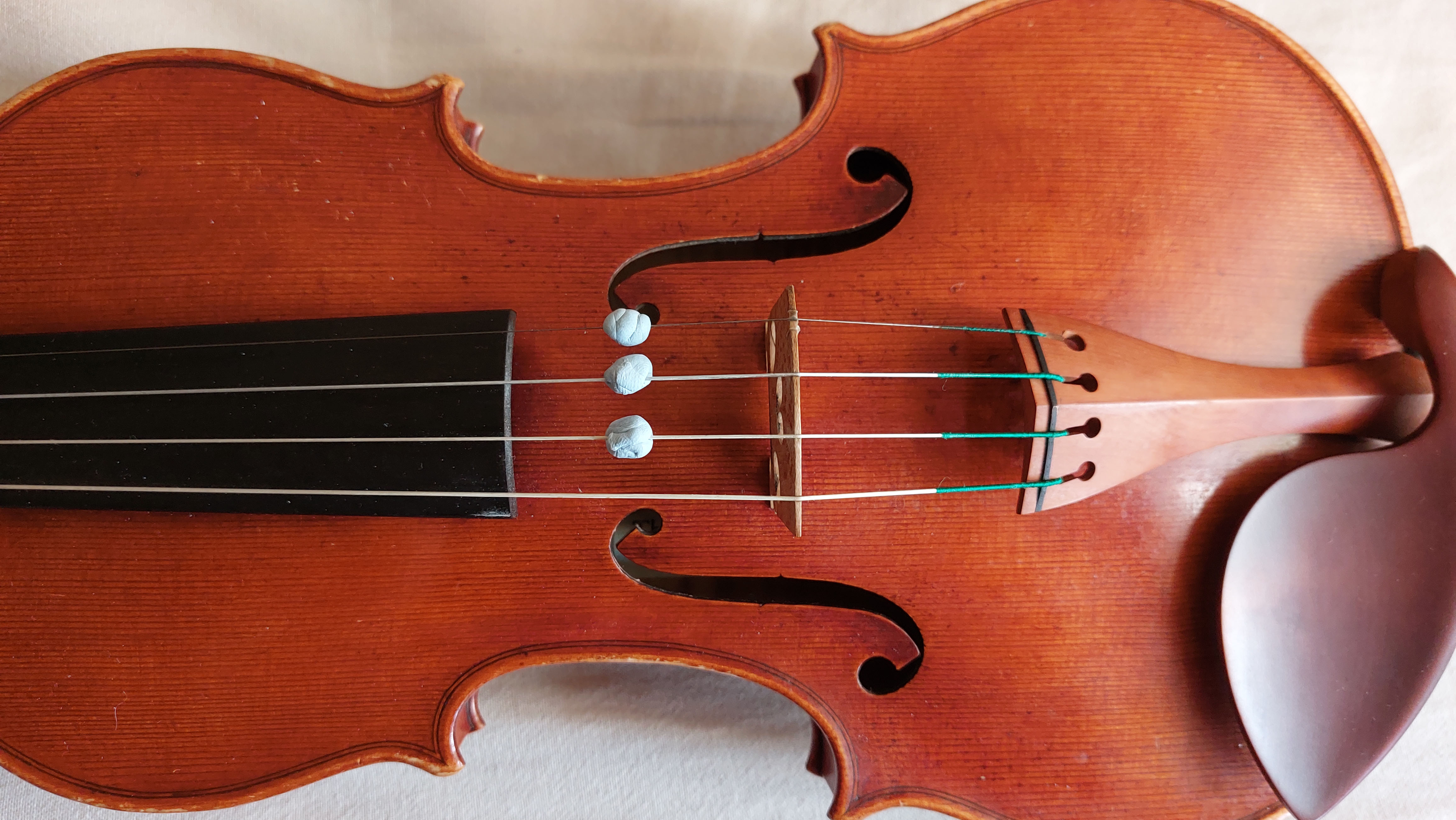
- Wojtek Blecharz: Phenotype

░░ ░░ ░░ ░░ ░░ ░░ ░░ ░░ ░░ ░░ ░░ ░░ ░░ ░░ ░░ ░░ ░░ ░░ ░░ ░░ ░░ ░░ ░░ ░░ ░░ ░░
Useful literature and books
⊶ Strange P., Stange, A. (2001) “The Contemporary Violin: Extended Performance Techniques” (The New Instrumentation), Scarecrow Press
⊶ Arditti, I. and Platz, R. HP. (2013). The Techniques of Violin Playing, Barenreiter-Verlag Karl Votterle
⊶ Maurer, B. (2015). Saitenweise : neue klangphänomene auf streichinstrumenten und ihre notation. Breitkopf and Haertel [in german]
⊶ Polansky, L.: A FEW WORDS ABOUT TUNING [in SS20 "The Just Intonation Issue"]
░░ ░░ ░░ ░░ ░░ ░░ ░░ ░░ ░░ ░░ ░░ ░░ ░░ ░░ ░░ ░░ ░░ ░░ ░░ ░░ ░░ ░░ ░░ ░░ ░░ ░░
If interested in examples of scores (or mentioned literature), do not hesitate to ask (some things can be provided)!
░░ ░░ ░░ ░░ ░░ ░░ ░░ ░░ ░░ ░░ ░░ ░░ ░░ ░░ ░░ ░░ ░░ ░░ ░░ ░░ ░░ ░░ ░░ ░░ ░░ ░░
